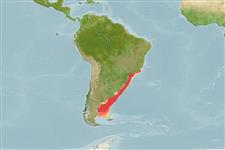Common names from other countries
分类 / Names
俗名 | 同种异名 | Catalog of Fishes(属, 种) | ITIS | CoL | WoRMS | Cloffa
Teleostei >
Clupeiformes (Herrings)
鯡目 (Herrings) >
Engraulidae (Anchovies)
鯷科 (Anchovies) > Engraulinae
Etymology: Engraulis: Greek, eggraulis, -eos = anchovy (Ref. 45335).
More on authors: Hubbs & Marini.
Environment: milieu / climate zone / depth range / distribution range
生态学
海洋; 海洋洄游的 (Ref. 51243); 深度上下限 30 - 200 m (Ref. 189). 亞熱帶的; 21°S - 50°S, 67°W - 34°W (Ref. 54431)
Southwest Atlantic: north of Rio de Janeiro, Brazil to San Jorge Gulf, Argentina.
西南大西洋: 巴西里約熱內盧到桑河 Jorge 灣,阿根廷北方。
Length at first maturity / 大小 / 重量 / 年龄
Maturity: Lm 9.2, range 8 - 10.2 cm
Max length : 17.0 cm SL 雄鱼/尚未辨别雌雄; (Ref. 189); 最大体重: 25.00 g (Ref. 4883)
背棘 (总数) : 0; 背的软条 (总数) : 15 - 16; 臀棘: 0; 臀鳍软条: 17 - 21. Snout prominent, pointed, about 3/4 eye diameter; maxilla moderate, tip bluntly tapering or a little rounded, reaching to front margin of pre-operculum, extending a little beyond tip of second supra-maxilla; teeth in jaws numerous, small. Lower gill rakers long and slender; no gill rakers on hind face of third epibranchial; pseudobranch long, reaching onto inner face of operculum (Ref.189). Blackish blue dorsally, silvery white laterally and ventrally. All fins transparent (Ref. 27363).
吻突出的,尖的, 大约 3/4 眼直径; 颚骨中等的, 顶端钝地尖端细的或稍微圆的, 延伸到前鳃盖的在前面边缘, 稍微延伸超过第二个上颚骨的顶端; 颚中的牙齿很多的, 小的。 下鳃耙长且细的; 没有在第三个上鳃骨的后部面貌上的鳃耙; 伪鳃长的, 延伸到鳃盖的内面上面.(参考文献 189) 黑色的蓝色背面, 银白色侧面地而且腹地。 所有的鳍透明.(参考文献 27363)
Occurs in coastal waters to about 800 km or more from the shore, forming dense schools at about 30 to 90 m depth in summer, but down to 100 to 200 m during winter. Feeds as juveniles on zooplankton, but with phytoplankton becoming increasingly important. Spawns throughout the year, most intensely and close to shore in October or November and again in May or June but less intensely and more offshore. Exhibits north-south and near shore-offshore migrations. During winter as the most favorable feeding period for larvae which occurs in the continental shelf in the extreme south of Brazil (Ref. 53892). Consumed fresh or canned (Ref. 4931).Typical size 7-13 cm SL (Ref. 47377).
出现于沿岸水域到大约 800 公里或更多距离岸边, 形成密集的鱼群在夏天于大约 30 到 90 公尺深, 但是在冬天期间向下至 100 到 200 公尺。 稚鱼捕食浮游动物, 但是有变成逐渐重要的浮游植物。 产卵全年度, 大多数的密集且接近海岸在十月或十一月与再一次五月或六月时但是更不密集与更外海。 显示南北而近岸-离岸回游。 在冬天期间当对于在巴西的南端中出现于大陆棚中的仔鱼的最有利的摄取食物的时期.(参考文献 53892) 生鲜消费或装于罐头。 (参考文献 4931)典型的大小 7-13 公分 SL.(參考文獻 47377)
Life cycle and mating behavior
Maturities | 繁殖 | Spawnings | Egg(s) | Fecundities | 仔鱼
西南大西洋: 巴西里約熱內盧到桑河 Jorge 灣,阿根廷北方。
Whitehead, P.J.P., G.J. Nelson and T. Wongratana, 1988. FAO Species Catalogue. Vol. 7. Clupeoid fishes of the world (Suborder Clupeoidei). An annotated and illustrated catalogue of the herrings, sardines, pilchards, sprats, shads, anchovies and wolf-herrings. FAO Fish. Synop. 125(7/2):305-579. Rome: FAO. (Ref. 189)
CITES (Ref. 128078)
Not Evaluated
人类利用
渔业: 高经济性
工具
特别资料
下载 XML
网络资源
Estimates based on models
Preferred temperature (Ref.
115969): 4.6 - 18.7, mean 8.2 (based on 187 cells).
Phylogenetic diversity index (Ref.
82804): PD
50 = 0.5020 [Uniqueness, from 0.5 = low to 2.0 = high].
Bayesian length-weight: a=0.00490 (0.00371 - 0.00646), b=3.13 (3.09 - 3.17), in cm Total Length, based on LWR estimates for this species (Ref.
93245).
营养阶层 (Ref.
69278): 2.5 ±0.00 se; based on food items.
回复力 (Ref.
120179): 中等的, 族群倍增时间最少 1.4 - 4.4年 (K=0.2-0.3).
Prior r = 0.56, 95% CL = 0.37 - 0.84, Based on 1 data-limited stock assessment.
Fishing Vulnerability (Ref.
59153): Moderate vulnerability (35 of 100).
Climate Vulnerability (Ref.
125649): Low vulnerability (12 of 100).
